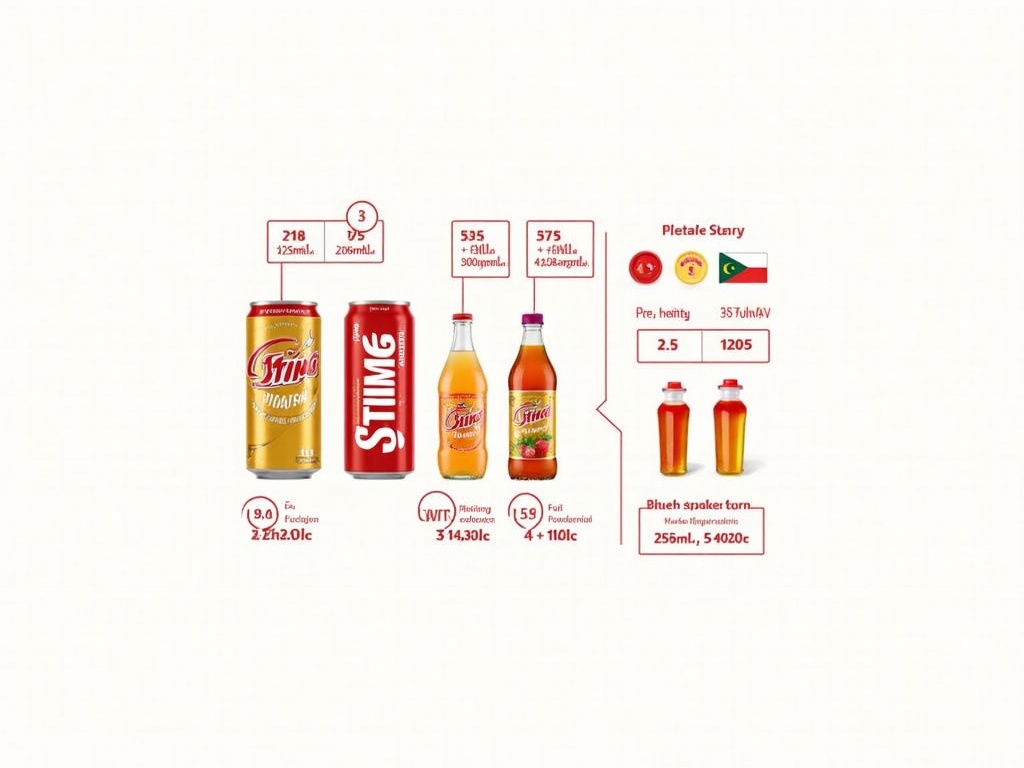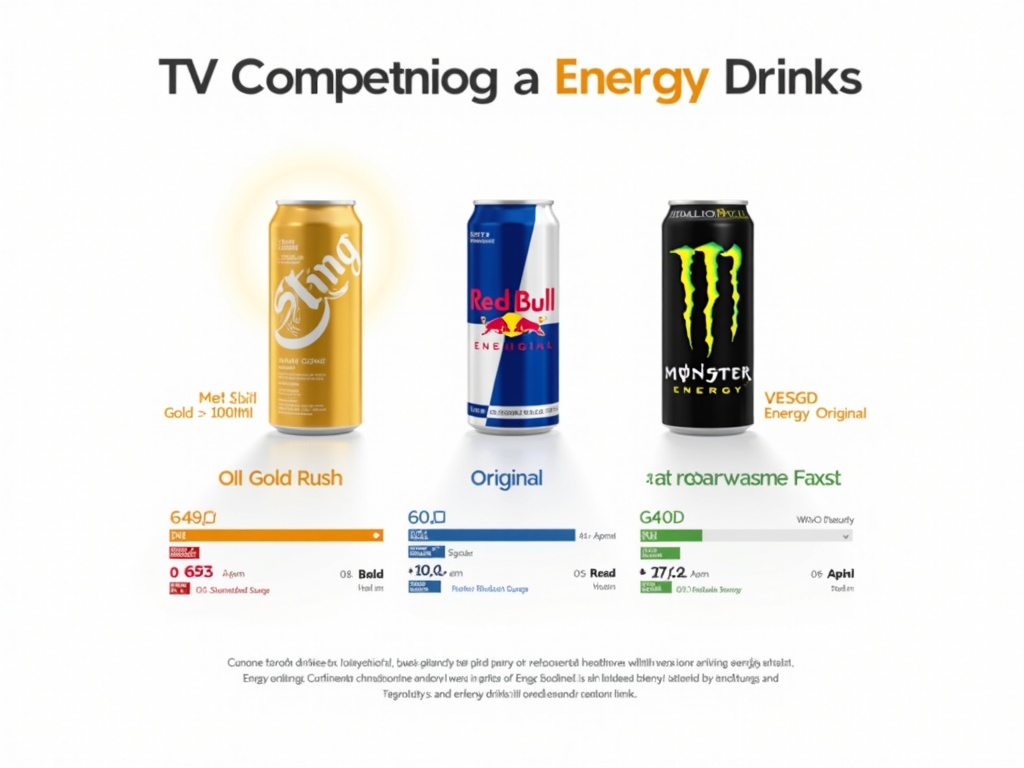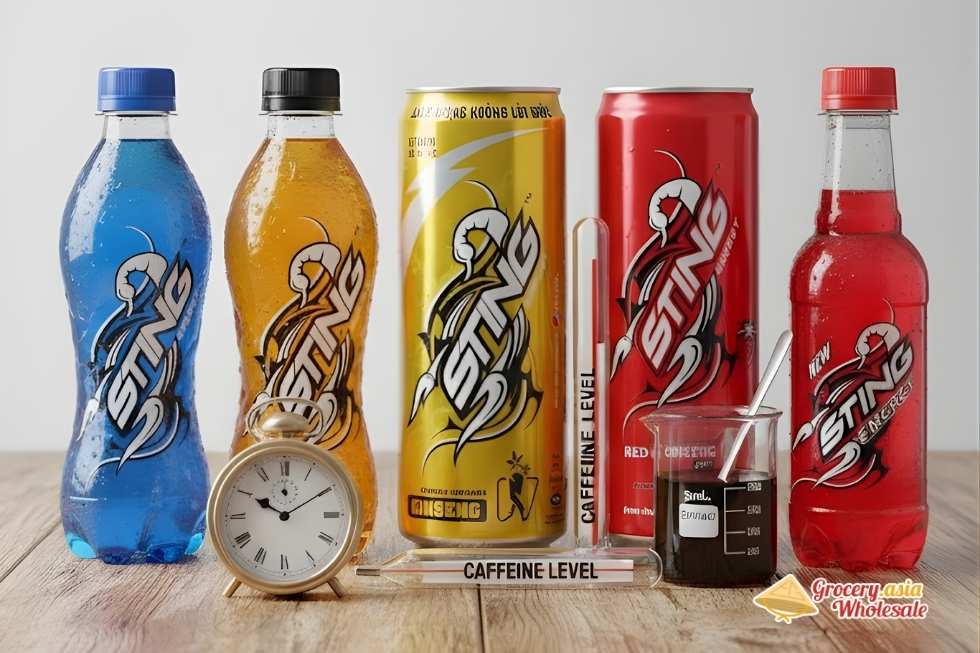No products in the cart.
Beverages News, Energy Drinks
How Many Calories In Sting Energy Drink Per Serving
Sting energy drink packs approximately 160 calories into each standard 250ml serving. Different flavors like Gold Rush and Strawberry show slight variations in their calorie counts. Sugar drives almost all of these calories, with each can delivering about 40 grams of added sugar that surpasses daily recommended limits for most adults.
Table of Contents
Key Takeaways
- Standard serving size: 160 calories per 250ml can, equivalent to 64 calories per 100ml across most Sting varieties
- Sugar dominance: Nearly 100% of calories come from 40 grams of added sugar, providing no essential nutrients
- Higher calorie density: Sting contains more calories per 100ml than competitors like Red Bull (44 calories) and Monster Energy (44 calories)
- Daily intake impact: One can provides 8% of a 2,000-calorie diet and exceeds recommended daily sugar limits for both men and women
- Regional variations: Calorie content may differ slightly between manufacturing locations and flavor variants, making label checking essential
Sting Energy Drink: Calories and Nutritional Facts
I’ve analyzed the caloric content across different Sting energy drink varieties and sizes to provide you with accurate nutritional information. The calorie count varies significantly depending on the specific flavor and serving size you choose.
Calorie Breakdown by Flavor and Size
Sting Gold Rush with ginseng flavor contains approximately 160 calories per 250ml can. This represents the standard caloric density you’ll find across most Sting varieties when adjusted for serving size.
Sting Strawberry delivers between 192-200 calories per 300ml or 330ml bottle. When standardized to the common 250ml serving size, this equals about 160 calories per 250ml, or 64 calories per 100ml. This consistency across flavors suggests Sting maintains similar sugar and carbohydrate levels regardless of taste profile.
The brand’s most common serving sizes include 250ml aluminum cans and 300ml-330ml PET bottles. You’ll encounter these formats across different markets, though availability depends on your location and local distribution preferences.
Regional Variations and Label Considerations
Calorie content depends on several factors including serving size, specific flavor, and manufacturing region. I’ve noticed that values may vary slightly due to formulation differences between Vietnam, the Philippines, and Pakistan manufacturing facilities. These variations typically remain minimal but can affect the exact caloric content you consume.
Different regions sometimes adjust Sting energy drink ingredients based on local regulations, taste preferences, or available sweetener options. Manufacturing standards and quality control processes can also contribute to minor nutritional variations between batches and regions.
I always recommend checking the nutrition label on your specific product for the most accurate information. Labels provide precise details about calories, carbohydrates, sugars, and other nutritional components specific to that particular batch and manufacturing location.
The consistent caloric density of approximately 64 calories per 100ml across different Sting varieties makes it easy to calculate your intake regardless of serving size. Whether you’re consuming a 250ml can or a larger 330ml bottle, you can accurately determine your caloric consumption by applying this standard measurement.
Sting energy drink phenomenon continues to grow partly due to its consistent nutritional profile across different markets. This reliability helps consumers make informed decisions about their energy drink consumption and daily caloric intake.
When comparing Sting to other energy drinks in the market, its caloric content falls within the typical range for sugar-sweetened energy beverages. The 160 calories per 250ml serving provides substantial energy from carbohydrates while delivering the caffeine and other active ingredients that make Sting energy drink boosts effective for many consumers.
Understanding these nutritional facts helps you incorporate Sting into your daily routine while maintaining awareness of your overall caloric intake. The clear relationship between serving size and calories makes portion control straightforward when you want to manage your energy drink consumption effectively.

Sugar Content: The Main Source of Calories
I’ve analyzed Sting’s nutritional profile and discovered that sugar drives virtually all the calories in this energy drink. The energy drink ingredients reveal that protein and fat contribute negligible calories, leaving sugar as the primary caloric component.
Breaking Down Sugar Content by Variant
Different Sting variants contain varying amounts of sugar that directly translate to their calorie counts:
- Sting Gold Rush (250ml) contains approximately 40g of sugar
- Sting Strawberry (300ml) packs around 48g of sugar
- Each gram of sugar provides exactly 4 calories
- This means 40g of sugar equals 160 calories
I calculate that nearly 100% of Sting’s calories come from added sugar, making it essentially a sweetened caffeine delivery system. To put this in perspective, 40g of sugar equals about 10 teaspoons — that’s more sugar than most people add to their coffee in an entire day.
These calories fall into the category of “empty calories” because they provide energy without delivering essential nutrients like vitamins, minerals, or fiber. While the instant energy boost might seem appealing, the nutritional value remains minimal.
The high sugar concentration creates a rapid spike in blood glucose levels, which explains why Sting delivers such immediate energy. However, this same mechanism often leads to energy crashes later in the day as your blood sugar drops below normal levels. Your body processes these simple sugars quickly, leaving you potentially more tired than before you consumed the drink.
I recommend understanding this sugar-calorie relationship when incorporating Sting into your daily routine. The energy drink phenomenon continues to grow, but awareness of sugar content helps you make informed decisions about consumption frequency and timing.
How Sting Compares to Other Popular Energy Drinks
I’ve analyzed the nutritional profiles of leading energy drinks to show you exactly where Sting stands in the competitive landscape. The comparison reveals significant differences in caloric density that directly impact your daily energy intake and health goals.
Caloric Density Breakdown Per 100ml
Breaking down the numbers on a standardized per-100ml basis provides the clearest picture of what you’re consuming:
- Sting (Gold Rush): 64 calories, 16g sugar
- Red Bull (Original): 44 calories, 10.8g sugar
- Monster Energy (Original): 44 calories, 11.4g sugar
These figures immediately highlight Sting’s position as the most calorie-dense option among the three major brands. When you consider Sting energy drink ingredients, the higher sugar content becomes the primary driver of these elevated calorie counts.
A standard 250ml Sting can delivers more calories and sugar than both Red Bull and Monster, despite Red Bull and Monster typically coming in larger serving sizes. This creates an important consideration for consumers who monitor their daily caloric intake. Sting’s caloric density means that even smaller servings can significantly contribute to your daily sugar consumption.
The mathematics work against health-conscious consumers when choosing Sting. While Red Bull and Monster contain fewer calories per unit volume, Sting concentrates its energy delivery through higher sugar content. This approach aligns with certain Sting drink marketing strategies that emphasize immediate energy impact over lower-calorie alternatives.
For perspective, consuming a full 250ml can of Sting Gold Rush means ingesting 160 calories and 40 grams of sugar. Compare this to Red Bull’s 110 calories and 27 grams of sugar per 250ml, and the difference becomes substantial for regular consumers. Monster Energy delivers similar numbers to Red Bull, making both alternatives lighter choices for calorie-conscious individuals.
The implications extend beyond simple calorie counting. Higher sugar density affects blood glucose response, energy crash patterns, and long-term metabolic health. Regular Sting consumption requires more careful dietary planning to avoid exceeding recommended daily sugar limits, which the World Health Organization sets at 25 grams for optimal health.
Despite these considerations, Sting’s approach isn’t necessarily inferior—it simply serves different consumer needs. Some athletes and individuals requiring immediate glucose availability might prefer Sting’s concentrated energy delivery. However, current energy drink trends show increasing consumer preference for lower-sugar, lower-calorie alternatives.
The competitive landscape continues evolving as brands respond to health-conscious consumers. While the Sting energy drink phenomenon has gained significant traction in Asian markets, nutritional awareness drives many consumers toward alternatives with better calorie-to-energy ratios.
Understanding these differences helps you make informed decisions based on your specific health goals, activity levels, and dietary restrictions. If you’re comparing Sting vs Red Bull for performance, consider not just immediate energy impact but also long-term nutritional consequences.
Your choice between these energy drinks should factor in frequency of consumption, overall diet quality, and personal health objectives. Occasional Sting consumption presents minimal concern for most healthy adults, but regular intake requires careful consideration of its higher caloric and sugar content compared to mainstream competitors.

Impact on Your Daily Diet
Understanding Calorie Contribution
I need to put Sting’s calorie content into perspective for your daily nutrition goals. Women typically require around 2,000 calories daily, while men need approximately 2,500 calories. A single 250ml can of Sting contains 160 calories, which accounts for 8% of a 2,000-calorie diet. This percentage might seem modest, but it represents a substantial portion when you consider this comes from just one beverage without any nutritional benefits like protein, healthy fats, or essential vitamins.
Sugar Content Creates Major Concerns
The sugar impact from Sting energy drink ingredients presents the most significant dietary challenge. Each can delivers 40g of sugar, which dramatically exceeds the American Heart Association’s recommended daily limits. Men should consume no more than 36g (9 teaspoons) of added sugar daily, while women should limit intake to 25g (6 teaspoons). A single Sting can surpasses these guidelines entirely, leaving no room for any other sources of added sugar throughout your day.
Multiple cans compound this problem exponentially. Consuming two cans daily doubles your sugar intake to 80g, contributing to weight gain, insulin resistance, and increased heart disease risk. Liquid sugar proves particularly problematic because it doesn’t trigger the same satiety signals as solid foods. Your brain doesn’t register these calories effectively, making overconsumption easier and potentially leading to additional calorie intake from other sources.
I recommend treating Sting as an occasional beverage rather than a daily habit. If you’re managing your sugar or calorie intake for weight management or health conditions, consider how Sting energy drink boosts might fit into your broader dietary strategy. The immediate energy benefits don’t justify regular consumption when healthier alternatives exist for sustained energy throughout your day.
Moderation becomes essential for anyone incorporating energy drinks into their routine. Track your daily sugar intake from all sources, including hidden sugars in processed foods, to maintain awareness of your total consumption. Consider limiting Sting to pre-workout sessions or particularly demanding days when you need immediate energy, rather than making it a regular dietary component.
Identifying Sting Energy Drink Variants and Their Caloric Content
I’ve discovered that Sting energy drink’s calorie content varies significantly depending on the flavor and geographic region where you purchase it. The two primary variants you’ll encounter are Gold Rush (featuring ginseng) and Strawberry, each carrying different caloric loads due to their unique formulations.
Regional availability plays a crucial role in determining what options you’ll find on store shelves. Some markets offer sugar-free or reduced-sugar versions that dramatically cut the calorie count, while others stick to the traditional high-sugar formulas. This variation stems from local consumer preferences and regulatory requirements that differ from country to country.
Understanding Serving Sizes and Ingredient Variations
Container size directly impacts your total calorie intake when consuming Sting energy drinks. Standard cans typically contain fewer calories than the larger 330ml bottles, which naturally pack more sugar and energy per serving. I recommend checking the energy drink ingredients list on your specific container to understand exactly what you’re consuming.
Country-specific labeling laws and ingredient regulations can cause slight variations in caloric content even within the same flavor variant. What you find in one market might differ from another due to:
- Local sugar regulations and taxation policies
- Available artificial sweetener options
- Consumer taste preferences requiring formula adjustments
- Manufacturing facility variations and sourcing differences
I always stress the importance of reading nutrition facts directly from your can or bottle rather than relying on general estimates. Marketing strategies and product formulations can change, affecting the caloric content you’ll actually consume. The Sting energy drink phenomenon has led to frequent product innovations and regional adaptations that impact nutritional values.
Controlling your daily energy and sugar intake becomes much easier when you understand serving sizes and caloric variations. Limited edition flavors sometimes appear in certain markets with completely different nutritional profiles, so I recommend staying vigilant about checking labels whenever you try a new variant or purchase from a different region.
Sources:
PepsiCo: Product Nutritional Information
FatSecret: “Sting Energy Drink – Nutrition Facts”
MyFitnessPal: “Sting Energy Drink – Calories and Sugar”
American Heart Association (AHA): “How Much Sugar Is Too Much?”


